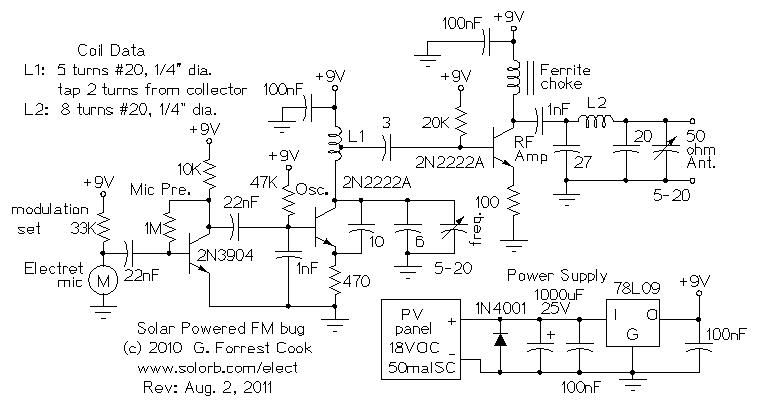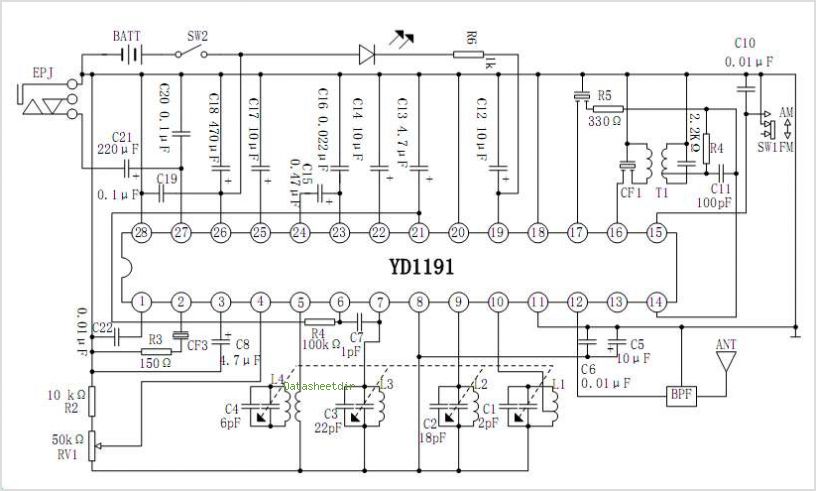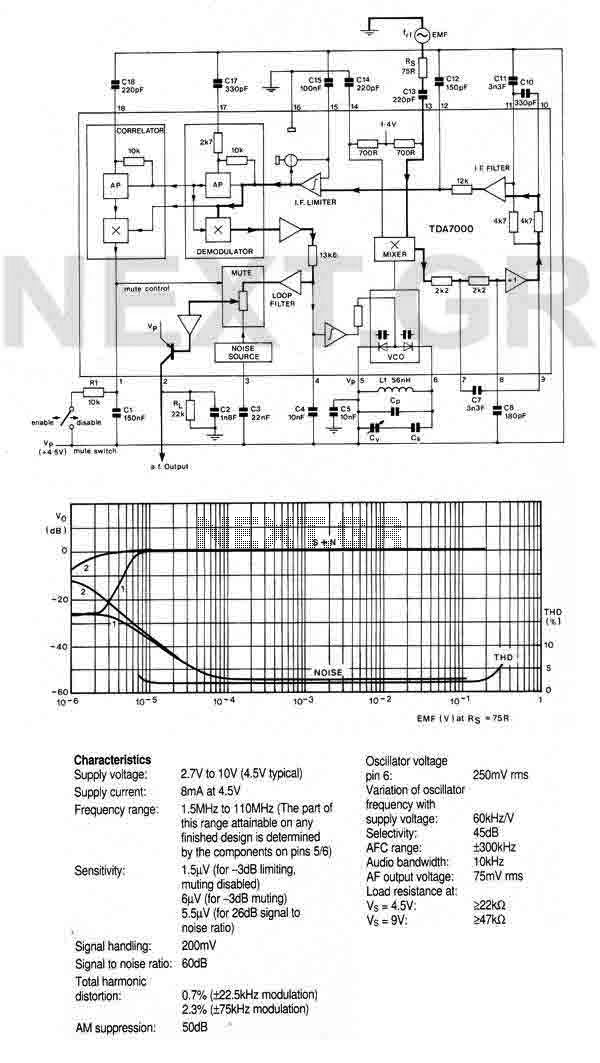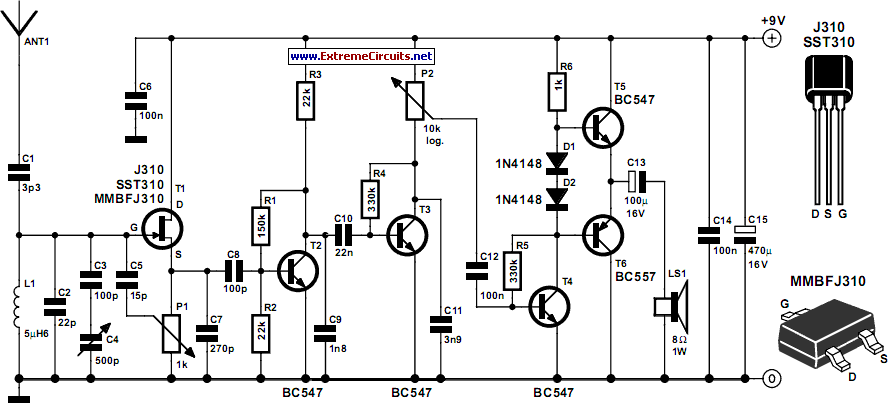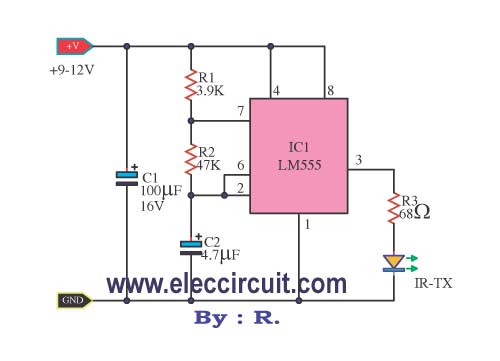
Small Radio Transmitter
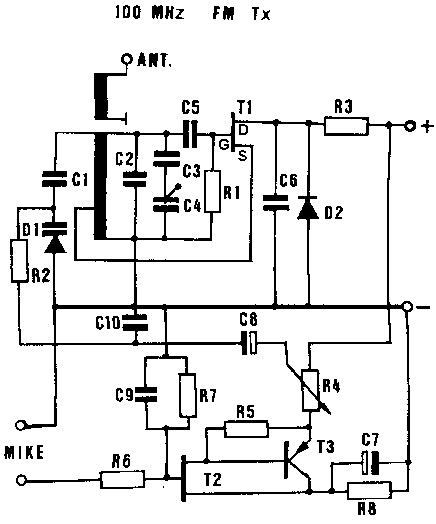
This ZIP file contains information about building a small radio transmitter, which has a PCB 1.75" x 2.5" (45mm x 68 mm) and has a range of about 30 yards or so. The documentation with the circuit says the freq range is 100-108 MHz, but I have found it to be more like 85-100 MHz. The circuit is (of course) only mono, and accepts an audio input from either a microphone or other source. The input impedance is 1Mohm. The input sensitivity is 5mV and the max input signal is 10mV. The transmitted signal can be picked up on a FM radio. The circuit can be used for short-range transmission, eg. for wireless microphones. The actual circuit comes from a Kit, available from Veleman electronics (USA distributor is Tapto Corp., PO Box 1339, CLAREMONT NH-03743-US. UK distributor is High-Q Electronics, 382 Edgware Road, London, W2 1EB). The kit number is K1771. It is a very good transmitter.
The described radio transmitter circuit is a compact and efficient design suitable for short-range audio transmission. The printed circuit board (PCB) dimensions of 1.75" x 2.5" (45mm x 68 mm) indicate a design optimized for portability and ease of integration into various applications. The operating frequency range of approximately 85-100 MHz, while noted to be slightly lower than the documented 100-108 MHz, is still suitable for FM broadcasting, allowing for effective transmission over a distance of around 30 yards.
The circuit is mono and designed to accept audio input from various sources, such as microphones or other audio devices. With an input impedance of 1 MΩ, the circuit is compatible with most audio sources, ensuring minimal loading effect on the input signal. The input sensitivity is set at 5 mV, allowing for the detection of weak audio signals, while the maximum input signal is limited to 10 mV to prevent distortion during transmission.
The transmitter's output can be easily received by standard FM radios, making it an ideal solution for applications like wireless microphones or other short-range audio communication systems. The availability of the kit from Veleman Electronics, with distribution channels in both the USA and the UK, facilitates access for hobbyists and professionals interested in building this transmitter. The kit number K1771 indicates that it is a well-documented and supported product, which aids in the assembly and troubleshooting processes.
Overall, this small radio transmitter circuit presents a valuable tool for those seeking to experiment with FM transmission technology, providing essential features in a compact design.This ZIP file contains information about building a small radio transmitter, which has a PCB 1.75" x 2.5" (45mm x 68 mm) and has a range of about 30 yards or so. The documentation with the circuit says the freq range is 100-108 MHz, but I have found it to be more like 85-100 MHz.
The circuit is (of course) only mono, and accepts an audio input from either a microphone or other source. The input impedance is 1Mohm. The input sensitivity is 5mV and the max input signal is 10mV. The transmitted signal can be picked up on a FM radio. The circuit can be used for short-range transmission, eg. for wireless microphones. The actual circuit comes from a `Kit`, available from Veleman electronics (USA distributor is Tapto Corp., PO Box 1339, CLAREMONT NH-03743-US.
UK distributor is High-Q Electronics, 382 Edgware Road, London, W2 1EB). The kit number is K1771. It is a very good transmitter. 🔗 External reference
The described radio transmitter circuit is a compact and efficient design suitable for short-range audio transmission. The printed circuit board (PCB) dimensions of 1.75" x 2.5" (45mm x 68 mm) indicate a design optimized for portability and ease of integration into various applications. The operating frequency range of approximately 85-100 MHz, while noted to be slightly lower than the documented 100-108 MHz, is still suitable for FM broadcasting, allowing for effective transmission over a distance of around 30 yards.
The circuit is mono and designed to accept audio input from various sources, such as microphones or other audio devices. With an input impedance of 1 MΩ, the circuit is compatible with most audio sources, ensuring minimal loading effect on the input signal. The input sensitivity is set at 5 mV, allowing for the detection of weak audio signals, while the maximum input signal is limited to 10 mV to prevent distortion during transmission.
The transmitter's output can be easily received by standard FM radios, making it an ideal solution for applications like wireless microphones or other short-range audio communication systems. The availability of the kit from Veleman Electronics, with distribution channels in both the USA and the UK, facilitates access for hobbyists and professionals interested in building this transmitter. The kit number K1771 indicates that it is a well-documented and supported product, which aids in the assembly and troubleshooting processes.
Overall, this small radio transmitter circuit presents a valuable tool for those seeking to experiment with FM transmission technology, providing essential features in a compact design.This ZIP file contains information about building a small radio transmitter, which has a PCB 1.75" x 2.5" (45mm x 68 mm) and has a range of about 30 yards or so. The documentation with the circuit says the freq range is 100-108 MHz, but I have found it to be more like 85-100 MHz.
The circuit is (of course) only mono, and accepts an audio input from either a microphone or other source. The input impedance is 1Mohm. The input sensitivity is 5mV and the max input signal is 10mV. The transmitted signal can be picked up on a FM radio. The circuit can be used for short-range transmission, eg. for wireless microphones. The actual circuit comes from a `Kit`, available from Veleman electronics (USA distributor is Tapto Corp., PO Box 1339, CLAREMONT NH-03743-US.
UK distributor is High-Q Electronics, 382 Edgware Road, London, W2 1EB). The kit number is K1771. It is a very good transmitter. 🔗 External reference
